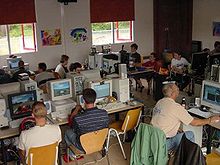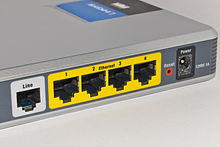LAN party
A LAN party is a
The size of these networks may vary from as few as two people to very large gatherings of a hundred or more. Small parties can form spontaneously and take advantage of common household networking equipment, but larger ones typically require more planning, equipment and preparation, even dedicated gaming
Small parties
This section needs additional citations for verification. (September 2021) |

Usually, smaller LAN parties consist of people bringing their computers over to each other's houses to host and play multiplayer games.
These are sometimes established between small groups of friends, and hosted at a central location or one that is known to all participants. Such events are often organized quickly with little planning, and some overnight events, with some stretching into days (or even weeks). Because of the small number of players, games are usually played on small
If the venue lacks Wi-Fi, an ad hoc network may be set up, thereby eliminating the need for a wired network. Providing refreshments is often also a duty of the host, though guests are usually asked to contribute. In larger parties where participants may not all know each other personally, an entry fee may even be charged. Another tradition of some small groups is to purchase large amounts of fast food for consumption over many days. Many LAN participants will also bring food or drink to consume over the course of the party—though they can be held at any hour, many LAN parties begin late in the evening and run through the next morning, making energy drinks a popular choice.
When some of the participants cannot be present or when merging a few LAN parties together,
Normally, the host will host the games but sometimes at very small LAN parties (e.g. 2 or 3 people) all participants will connect to an online internet server and add a word in front of their name to tell everyone else that they are a clan or group. At bigger LANs (e.g. 5 or more people) the host or a friend of the host will use a spare PC as a game server to serve all the participants. Usually the host and/or the owner are administrators.
The group can play together in another server as well if they wish as long as they are in the same LAN.
Private LAN parties were at their peak in popularity during the late 1990s to early 2000s when broadband internet access was either unavailable or too expensive for most people at the time. Another purpose for attending private LAN parties was also the opportunity to share software, movies or music among the participants. File-sharing over LAN networks provided a convenient way to exchange content among participants, as most average internet users did not have access to the high-speed and bandwidth that a broadband Internet connection offers to accommodate large file size downloads. Since the wide availability of high-speed internet, friends can more easily remotely play their multiplayer games together, using gaming-orientated software such as
Console-based LAN parties

While traditional LAN parties have solely consisted of computer gaming, the widespread adoption of network-centric console platforms, such as Xbox 360 and PlayStation 3, has led to an evolution in LAN parties. Modern consoles equipped with Ethernet ports are able to communicate with each other over standard routers or switches, much like traditional computers.[citation needed]
Console-LAN attendees need only their console, games, and television to garner the same local gaming experience as their computer-based counterparts. Many popular multiplayer games for the console have also been ported to the PC (e.g. Battlefield: Bad Company 2 and Halo: Combat Evolved). Developers have given consumers the choice to enjoy the same multiplayer games on multiple platforms, paving way for an alternative stage in 21st-century LAN parties.[citation needed]
Larger parties
This section needs additional citations for verification. (September 2021) |


Many commercialized parties offer various tournaments, with competitions in such games as
The duration of events is not standardized; organized parties often last for a weekend.
Big LAN parties often offer a quiet place to sleep, shower, and eat, as well as
Often case modders and overclockers attend these events to display their computers, which otherwise would be seen by few. Some come just to display their computers and look at others' computers.
Some attendees also use these parties for the purpose of
There are also other kinds of parties not referred to as "LAN parties" where temporary LANs are built but are not used as the main attraction. Amongst these are
In the traditionally active
Sponsorship
Many computer companies, including
Culture


LAN parties have their own unique culture. Enthusiasts often show off computers with extravagant aftermarket cooling systems, LED lighting effects, multi-display setups, and custom-built cases, and many other enhancements.[11] Highly caffeinated drinks, termed energy drinks, are very popular in these events to improve concentration and stamina, since LAN parties often run into the early morning hours.[12] Large parties can last for several days with no scheduled breaks. Most of the time, sleep is compromised to play for extended periods of time lasting from night to morning. There are also designated rooms separated from the LAN party for sleep.[citation needed]
Notable events
- CampZone, the world's largest outdoor LAN party held in the Netherlands.
- Cyberathlete Professional League, formerly one of the largest LAN events in the United States.[citation needed]
- DreamHack, claimed to be the largest LAN party in the world.[14] Held twice annually in Jönköping, Sweden.
- Euskal Encounter, the largest (6000 people) and oldest (since 1994) LAN party in Spain, celebrated every July at the Bilbao Exhibition Centre in Baracaldo.
- Fragapalooza, one of the largest LAN parties in Canada. Held in Edmonton, Alberta.
- Frag Infinity Tournament, F.I.T.E.S. LANsouth central Pennsylvania.
- Gaming Scotland, the largest Scottish LAN[16] party held at the Dobbie Hall, Scotland.
- Lan ETS, the largest LAN party in Canada. Held in Montreal, Quebec.
- Minho region, Portugal.
- Insomnia Gaming Festival,[17] the largest LAN party in the United Kingdom, hosted by Multiplay. Held twice annually at the National Exhibition Centre in Birmingham, England.
- NETWAR,[18] LAN party held bi-annually for charity in Omaha, Nebraska since 2003.
- Organised Chaos, Africa's largest monthly LAN party (1200 people). Held in the Bellville Velodrome in Cape Town, South Africa. Posted Over 2 days in the Weekend.
- PDXLAN,[19] is one of the largest family and friend oriented annual LAN parties in the Northwestern US.
- Pittsburgh, Pennsylvania.
- Dallas, Texas.
- The Big LAN, held in Melbourne, Australia is currently the largest LAN event in Australia. It runs four times a year and focuses more on casual/fun tournaments, rather than esports.[21]
- NAG LAN, held in various places in South Africa is currently the largest LAN event in South Africa. It runs once a year usually around early December.[22][23]
See also
- Block party
- Demoscene
- Install fest
- MIDI Maze
References
- ^ Kalke, Rushmie (22 October 2006). "CPUs get revved up in Hudson". Worcester Telegram & Gazette. Retrieved 2006-10-25.
- ^ "Largest LAN party". Guinness World Records.
- ^ "Events - GeForce". www.nvidia.com. Retrieved 9 April 2018.
- ^ "Cooler Master". Archived from the original on September 22, 2012.
- ^ "Welcome to Antec". www.antec.com. Retrieved 9 April 2018.
- ^ "Corsair Community: LAN Parties". Archived from the original on October 29, 2006.
- ^ "Alienware". www.alienware.com. Retrieved 9 April 2018.
- ^ "SteelSeries". Retrieved 9 April 2018.
- ^ "Sponsors – All Your Base Online". www.aybonline.com. Retrieved 9 April 2018.
- ^ "Thermaltake - U.S.A." thermaltakeusa.com. Retrieved 9 April 2018.
- ^ Dan Evans, Nathan Edwards (March 1, 2006). "Build It: The Ultimate Game Room; Stun your friends with the best place on earth to play games, including an amazing (and amazingly expensive) LAN party scoreboard. We show you how". PC Magazine. Vol. 25, no. 5.
- ^ "As In Risking Ours, For Science". The Life. 2005. Archived from the original on 2006-10-18. Retrieved 2006-11-08.
- Wired magazine. (August 3, 2001)
- ^ Guinness World Records site January 7, 2008. Retrieved August 29, 2008.
- ^ "Frag Infinity Tournament, Inc. - FITES LAN Party - www.fites.net - Portal". www.fites.net. Retrieved 2016-12-31.
- ^ Falkirk Herald Website. 31 August 2006. Retrieved 13 January 2011.
- ^ "Home". Insomnia Gaming Festival | A Celebration Of Gaming.
- ^ NETWAR.
- ^ PDXLAN.
- ^ "The Gathering Tech:Server". techserver.gathering.org. Retrieved 9 April 2018.
- ^ "The Big LAN Tech:Server". http://thebiglan.com=9 September 2022.
- ^ "NAG LAN | Southern Africa's Largest BYOC LAN". naglan.co.za. December 2023. Archived from the original on 8 January 2024. Retrieved 8 January 2024.
- ^ "Experience South Africa's biggest BYOC LAN". rageexpo.co.za. December 2023. Archived from the original on 8 January 2024. Retrieved 8 January 2024.
External links
- The LAN Party Exchange - US LAN Party List
- LAN Party List - Worldwide list of LAN Parties
- LAN parties at Curlie
- LAN Link Network - Australian LAN Party Information
- lanlist.org - A List of LAN Parties, with a focus on the UK
- LAN Party EH - A List of LAN Parties, with a focus on Canada
- LAN Party guide at Tom's Hardware Guide
- Running a LAN
- LAN Survival guide
